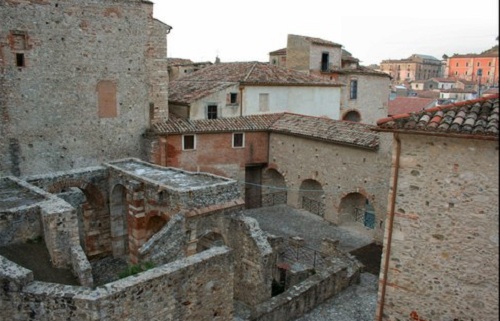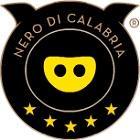The ancient Cosenza was, according to Roman historian Strabo, the capital of the Bruzi people who later came under the influence of the Greeks.
In 204 BC it was conquered by the Romans, and
Today Cosenza is an important industrial and commercial hub, the chief city of northern Calabria, located in the extreme south of the Crati valley.
This city, which is also the provincial capital, lies in the Crati valley where the Busento flows in, between the Tyrrhenian coast and Sila Grande.
Founded in the remote past, ancient Consentia, which was already a bustling town between the 4th and 3rd centuries BC, was conquered by the Romans in 204 BC and became very important during the imperial era. became an important communication center along the Via Popilia connecting Rome to Reggio and Sicily.
The Visigoth king Alaric died here in 410 AD; according to legend, after his death the Busento River was temporarily diverted so he could be buried in the riverbed with his treasures. Sacked numerous times by the Saracens, from Norman domination to the time of Spanish rule it was the most important city in Calabria. The 16th century marked a period of great cultural flourishing inspired by the Cosenza Accademia, which still exists today.
On July 26, 1844, during the Risorgimento, the Bandied brothers and their companions, who had attempted an insurrection, were shot by a firing squad here.
The church of S. Domenico, one of the city's largest monuments, was founded in 1448 and then rebuilt in the 18th century. Remains of the early edifice include the beautiful Gothic rose window in the front and various features in the interior, including the elegant• Rosario chapel with its Gothic apse. Nearby, one can visit the church of S. Francesco d'Assisi, founded in 1217 but rebuilt in the 17th century, and the 16th century church of S. Francesco da Paola.
The splendid cathedral is from the 12th-13th centuries.It has an open façade with three ogival portals, and an interior that holds the exquisite tomb of Isabella of Aragon, decorated with fine 12th century high relief work. Various historic edifices line the nearby Piazza XV Marzo, including the beautiful Prefecture, the Villa Comunale and the Rendano/theater. Built in the Norman period on Pancrazio hill, Frederick II expanded the imposing castle, which became a princely residence under the Angevins.
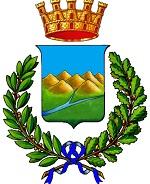 The ancient city lies on the left of the Crati just above the Busento confluence, on the north and east sides of Mount Pancrazio (383 m) topped by the Swabian-Angevin castle.
The ancient city lies on the left of the Crati just above the Busento confluence, on the north and east sides of Mount Pancrazio (383 m) topped by the Swabian-Angevin castle.
From the 15th century the city slowly developed, in various directions: the construction of the Sibari railway in 1878 and reclamation of the flat ground on the valley floor provided essential conditions for the expansion of the city on to the river terraces on the left of the Busento and Crati, west and north of their confluence.
Now the areas built to the left of the Busento and the Crati river are developing in orderly fashion that markedly contrasts with the untidy picturesque old centre on the right of the Busento.
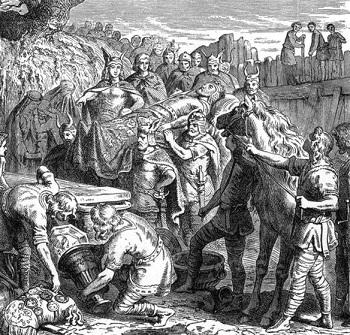 According to a legend, it is here that Alaric king of the Goths died in 410. His body, the legend goes, was buried under the river bed, the stream being temporarily turned aside from its course while the grave was dug. The king's grave and its fabulous treasure have never been found).
According to a legend, it is here that Alaric king of the Goths died in 410. His body, the legend goes, was buried under the river bed, the stream being temporarily turned aside from its course while the grave was dug. The king's grave and its fabulous treasure have never been found).
Due to its cultural past, Cosenza is identified as the Athens of Calabria. The Cosentian Academy, for example, was the second academy to be founded in the Kingdom of Naples and one of the first in Europe (1511). To this day, the city remains a cultural centre with several museums, theaters, libraries, and the University of Calabria.
The oldest examples of architecture are modest Roman remains: a stretch of opus reticulatum in Via Messer Andrea the remains of a construction which perhaps belonged to the famous Brezian fort, on the site of which the present castle was constructed.
The castle built by the Normans after the 1184 earthquake was later tranformed by Frederick II in the 13th century ( the period from which the octagonal tower dates ) and again rebuilt in the 15th-18th century.
Now restored to its original state, it has a rectangular plan with turret, an ogeee arched vestibule, and carved ledges and rib vaulted rooms.
The ancient Cathedral rebuilt to the plan of today after the 1184 earthquake and consecrated in the presence of emperor Frederick II of Swabia in 1222, was restored in the Baroque period and the front rebuilt in 1831.
Of pink sandstone it has a nave and two aisles divided by pillars. The facade has three arched tufa portals, a central rose window and two lobed lateral windows. Inside are the Gothic monument of Isabella of Aragon, by French craftsmen in the 14th century, and a marble sarcophagus with bas-relief, said to be Meleager of Atlanta and datable to the Hellenistic period.
The chapels off the left aisle were restored in the 18th century. Behind the cathedral is the archbishops' palace with painting from the 17th and 18th centuries and a rich treasure. There is a reliquary cross, a rare work by Sicilian artists of the Norman period ( 12th c ) ; it has precious stones and enamel decoration and was donated by Frederick II of Swabia.
The Church of San Francesco d'Assisi was built upon Basilian and Benedectine foundations. It belonged to the Conventuali ( 1276 ) and the Minori Osservanti ( 1434 ). The complex contain many traces of work carried out in the 14th and 16th centuries and the cloister contains architectural and sculptured fragments from the early edifice. The church incorporates the ornate Barouque chapepel of the oratory of the Confraternity of Santa Caterina d'Alessandria.
The church of San Domenico was built in the 16th century on the remains of a 15th century church; it has a large Gothic rose window, a marble chapel with statue of the Madonna della Febbre ( by 16th c.Neapolitan sculptors and the Oratory of the Rosario has wood carvings, stucco decoration and frescoes. The cloister with its cross vaulted ceiling is supported by 36 octagonal pillars and has portals with decorations showing Aragonese motifs.
The church of the ex-Monastery of the Vergini, founded in 1515, has a diamond-pointed stone doorway and a small courtyard with Baroque doors ( inside an ornate choir with gilded carvings from the 16th c.).
Isolated at the point where the Crati and the Busento meet is the church of San Francesco da Paola founded in 1510, rebuilt in the 18th and 19th centuries; the interior still has the original sepulchral monuments, epigraphs and frescoes.
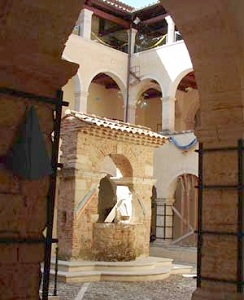 Many other old constructions should also be mentioned: the Benedectine church with its 13th century aps and single-arched windows and the smaller windows in the side walls; the church of Sant' Agostino (14th c ) with its arched and moulded portal; the facade of the church of the ex-Monastery of Santa Chiara now the Civic Library which has decorated portal and windows ( 16th c. ) and the church of San'Omobono of the Confraternity of the tailors, founded in 1565, with a decorated facade, 18th century frescoes in the interior, and the subterranean church of the ex-Monastery of the Cappuccinelle with pointed arch spans ( 13th c ).
Many other old constructions should also be mentioned: the Benedectine church with its 13th century aps and single-arched windows and the smaller windows in the side walls; the church of Sant' Agostino (14th c ) with its arched and moulded portal; the facade of the church of the ex-Monastery of Santa Chiara now the Civic Library which has decorated portal and windows ( 16th c. ) and the church of San'Omobono of the Confraternity of the tailors, founded in 1565, with a decorated facade, 18th century frescoes in the interior, and the subterranean church of the ex-Monastery of the Cappuccinelle with pointed arch spans ( 13th c ).
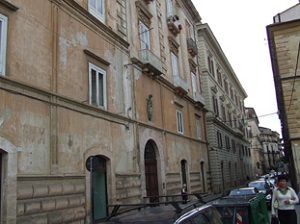 The 15th century Palazzo Sersale has an arched portal and elegant windows from the same period. A serie of great palaces are linked with the names of illustrious families or people and events.
The 15th century Palazzo Sersale has an arched portal and elegant windows from the same period. A serie of great palaces are linked with the names of illustrious families or people and events.
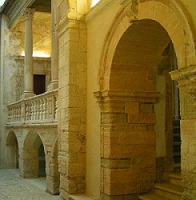 The 15th century Palazzo Vaccaro or Archi di Sambiase in Piazza Berardi , Palazzo dei Gaeta della Stella ( 15th 16th c. ) and the house of economist Antonio Serra with moulded balconies, windows and doorjambs ( 18th c. ) all on the same square.
The 15th century Palazzo Vaccaro or Archi di Sambiase in Piazza Berardi , Palazzo dei Gaeta della Stella ( 15th 16th c. ) and the house of economist Antonio Serra with moulded balconies, windows and doorjambs ( 18th c. ) all on the same square.
Many other palaces merit mention here; that of the Constable Ciaccios, of the Valvos ( both originally 15th c.) the house of the Castelli's with its courtyard and 17th c. covered stairway; the house of Galeazzo di Tarsia with sculptured decoration at the side of the portals and in the courtyard (16th c. ); the Palazzo of the Presidi di Calabria, today the lawcourt; the nearby Palazzo Ferrari d'Epaminonda ( 16th c. ) and the Palazzo del Govern with Neoclassical touches.
Many other houses with fine portals and balconies, characterize the streets of the old town, such as the Palazzo della prefettura ( piazza XV marzo ) and the nearby Villa Comunale. The Civic Museum has fine prehistoric finds, paintings from the 16th-18th c. and objects from the Risorgimento.



 According to a legend, it is here that Alaric king of the Goths died in 410. His body, the legend goes, was buried under the river bed, the stream being temporarily turned aside from its course while the grave was dug. The king's grave and its fabulous treasure have never been found).
According to a legend, it is here that Alaric king of the Goths died in 410. His body, the legend goes, was buried under the river bed, the stream being temporarily turned aside from its course while the grave was dug. The king's grave and its fabulous treasure have never been found).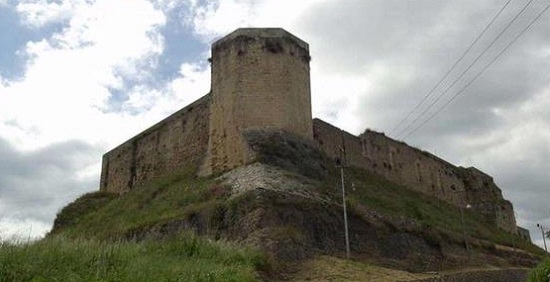
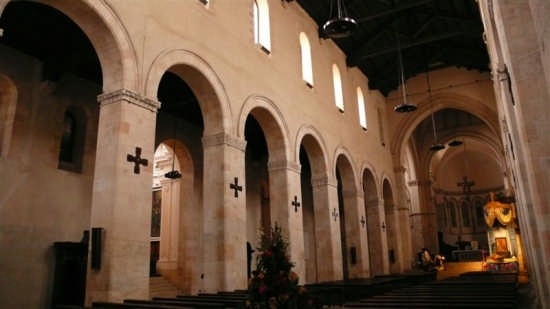
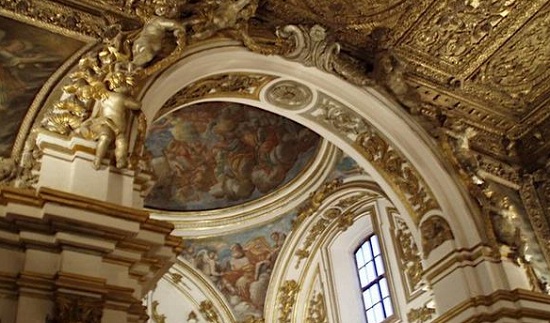
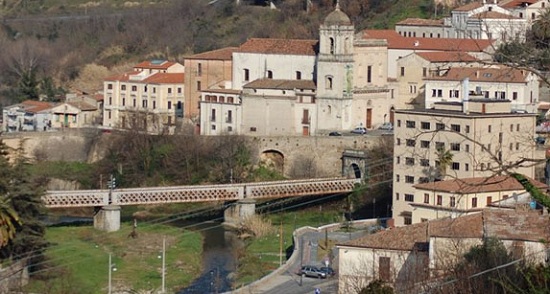

 The 15th century Palazzo Sersale has an arched portal and elegant windows from the same period. A serie of great palaces are linked with the names of illustrious families or people and events.
The 15th century Palazzo Sersale has an arched portal and elegant windows from the same period. A serie of great palaces are linked with the names of illustrious families or people and events.  The 15th century Palazzo Vaccaro or Archi di Sambiase in Piazza Berardi , Palazzo dei Gaeta della Stella ( 15th 16th c. ) and the house of economist Antonio Serra with moulded balconies, windows and doorjambs ( 18th c. ) all on the same square.
The 15th century Palazzo Vaccaro or Archi di Sambiase in Piazza Berardi , Palazzo dei Gaeta della Stella ( 15th 16th c. ) and the house of economist Antonio Serra with moulded balconies, windows and doorjambs ( 18th c. ) all on the same square. 